 |
Giant Ragweed - Ambrosia trifida
Although an herbaceous annual, it grows up to 15 feet. Opposite leaves, usually three-lobed with bristly hairs, grow up a tall, stiff stalk. Spikes
of green flowers in late summer. Huge colonies may be found in sunny disturbed places. Species of the Asteraceae, or composite, family commonly produce
pollen that triggers allergic reactions, and ragweed is especially well-known for this characteristic. Its pollen is actually used by pharmaceutical
companies to treat ragweed allergies. It is useful as an astringent, to stop bleeding, for treating fever, diarrhea, nosebleeds, and mouth sores.
American Indians made a leaf poultice to treat bug bites and chewed the root at night for its calming properties. Ragweed seeds are large with a tough
coat so animals do not often eat them.
|
|
Asters - Aster sp. (several species within the Asteraceae Family)
The genus Aster is complex; the flowers are closely related and difficult to differentiate. No one has identified the precise number of species
found here in Louisiana, but the flowers generally have a very similar structure to the common Sunflower. The basal leaves are key to identifying
particular species, however, they usually wither and die. Some of the species here at Acadiana Nature Station are A. lateriflorus, A. dumosus, A.
subulatus variety ligulatus, all very similar flowers called "white asters." A fourth species is A. praealtus, with lavender flowers up
to 8 feet tall. They all prefer sunny areas. |
 |
Horrid Thistle - Cirsium horridus
With spines up to 8 inches long, the Horrid Thistle almost names itself once stepped on, or even seen. Yellow, purple, or (rarely) red or white
corollas sit handsomely atop often solitary stems and a basal rosette up to 2 ft. in diameter. The plant reaches tall, depending on the type of
the soil it resides in: pine and prairie soils will support it up to 2 ft. tall while our alluvial soils at the Nature Station can allow it to
reach heights of up to 6 ft. tall, given the opportunity! This species is usually a winter annual, but re-seeds itself prolifically by sending out
fluffy floating white seeds. These seeds are eaten by songbirds, including Carolina Chickadees, and the nectar is used by hummingbirds and butterflies,
especially swallowtails.
|
| |
Elephant's Foot - Elephantopus carolinianus
Large basal leaves that lie flat on the ground will produce a stem with pink flower heads in the early fall. This particular species of Elephantopus
will have lost its basal leaves and grown large stem leaves at flowering time. |
| |
Showy Daisy Fleabane - Erigeron philadelphicus
The basal leaves of the Daisy Fleabane begin to grow in October or November, and beginning in December their stems (up to 30 in. tall) are produced.
It produces many flower heads in spring, about ½ in. diameter, colored from white to light pink with a yellow center. The petals are thin like hair,
and number about 150 per flower. These are seen at the Nature Station along the back levee on the edge areas since they tend not to grow under the
forest canopy. Its genus name is from the Greek eri (early) and geron (old man) presumably referring to the fact that the plant flowers early in the
year and has a hairy down, like an old man’s beard. Daisy fleabane tea has been used as a diuretic, an astringent, to treat diarrhea, kidney stones,
and to stop bleeding. |
| |
Dog Fennel - Eupatorium capillifolium
Grows up to six feet tall and shaped like a cypress tree with a central stem and downward-slumping branches all around. Small white flowers bloom in
late summer through fall and cover the top third, or even the top half, of the plant. Sometimes called "yankee-weed."
|
 |
Mist Flower - Eupatorium coelestinum
Clusters of small bluish flower are common in disturbed soils and the margins of wet sites from August until the frost (and occasionally in April).
Leaves are opposite and triangle-shaped with serrate margins. Grows up to 3 feet. Sometimes used by gardeners. |
| |
White Snakeroot - Eupatorium rugosum
Similar to mist flower above, but its flowers are white and its leaves are more pointed. Found in disturbed soils, fields, and woodlands. It is
poisonous to livestock; that poison is then transmissible to suckling young and humans by way of milk or butter. It is quite common, and many
deaths were attributed to its presence in the early 1800's. Abraham Lincoln’s mother died from snakeroot poisoning, called "milk sickness,"
when he was a child. Symptoms include prostration, vomiting, tremors, constipation, and delirium. Rarely happens today. American Indians would use the
roots in a tea to treat various diseases, or burn the plant to revive unconscious sick people with the smoke. |
 |
Rabbit Tobacco - Gnaphalium obtusifolium
In the first year of its life cycle, Rabbit Tobacco puts its energy into growing short hairy rosettes; then in the second year it will produce the
flowering stem with white flowers. The plant remains standing until the following spring, hence its alternate name, "sweet everlasting."
The name "rabbit tobacco" may refer to the peppery tobacco smell of its crushed leaves, or perhaps to its medicinal uses. Some think that
when brewed into a tea, it allows your lungs to breathe as a relief from asthma, or, in some accounts, relief from lung cancer. It is also used to
alleviate drunkenness, for sore throats, pneumonia, fever, abdominal cramps, and rheumatism, or as fresh juice for an aphrodisiac. Common in early
succession areas such as poor roadside soils or where recently plowed. |
| |
Sump Weed - Iva annua
Sump weed is an annual herb that grows up to 5 feet tall. The plant has small flower heads that are yellow or green and blooms July through November.
The plant attracts birds and the seeds once were used as food by indigenous people. |
 |
Wild Lettuce - Lactuca sp. (species undetermined)
Members of this genus are distinguished by a milky juice that flows from a broken or wounded stem. They are usually annuals or biennials with leaves
almost like an arrowhead and the flowers range from blue or violet to white to yellow. We usually see this tall plant along the edge of the boardwalk
in the open, sunny areas, sometimes with its head bent down in humble reverence for nature’s biodiversity. Seeds are occasionally eaten by songbirds
and small mammals. Although it may be poisonous to consume, American Indians and settlers may tea for various medicinal purposes. The milky juice can
serve as a substitute for rubber. |
| |
Santa Maria or Wild Quinine - Parthenium hysterophorus
It is an annual herbaceous plant that can grow up to 5 feet tall. Stems are green and covered in small stiff hairs. The leaves are alternately
arranged, simple, and decrease in size on the upper branches. The small, white, flower heads are arranged in clusters at the tips of the branches
and in the center. The plant can cause skin rashes, watery eyes, itching, coughing, and fatigue. It is found in riparian zones, roadsides, pastures,
seasonal floodplains, grasslands, and woodlands. |
| |
Goldenrod - Solidago sp.(several species)
Species of this genus will often hybridize freely, creating confusion among botanists as to the number of species, hybrids and varieties that can be
named. In general, Goldenrods are perennials with fibrous roots and terminal spikes of small, dense, yellow flowers in fall. It can grow tall and is
common especially in fallow fields. Songbirds and small mammals sometimes eat the seeds, and larger mammals may graze on the leaves in winter. In Germany,
the leaves of some species are approved for use as a diuretic to treat inflammation of the urinary tract. |
| |
Prickly Sow Thistle - Sonchus asper
This is a common species to see in open, somewhat recently disturbed soils such as fallow sugarcane fields. It has a fleshy stem with a milky juice
that oozes when cut, and a rosette of spinose, clasping leaves. A few yellow flowers sit atop a tall stem. Along the banks of our canal, the sow thistles
grow prolifically in the spring and early summer. |
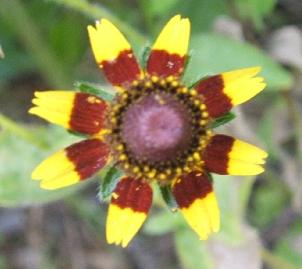 |
Gaillardia - Gaillardia aestivalis
Yellow ray flowers tinged with red around the brown center bloom all summer until frost. Grows in sunny areas all along the Gulf Coast. Can be found in abundance on the levee at the Acadiana Nature Park. |
| |
Blazing star - Liatris graminifolia
Beautiful tall spikes of purple flowers in the summer. Spikes grow up to about five feet and will usually slouch or fall over. Leaf tea was used for
bladder trouble and sore throats, and the root was mashed into a poultice to cover snake bites. Found along the levee.
|
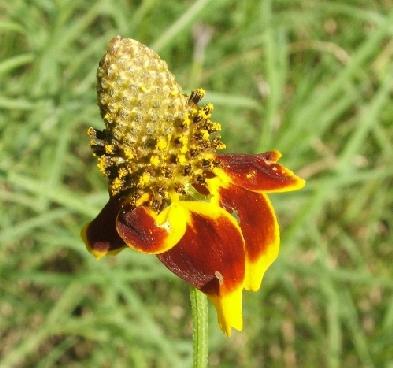 |
Mexican Hat - Ratibida columnaris
Perennial with several stems up to 2 feet high with leaves along the bottom half of the stem only. Terminal summer-blooming ray flowers have yellow
petals with red near the base and long cylindrical receptacles. Found in the sunny space along the levee at the Acadiana Nature Station. |
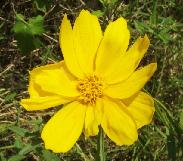 |
Coreopsis, Tickseed - Coreopsis lanceolata
1-inch yellow summer-blooming flowers. Each petal is split into three at the tip. Found along the levee. |
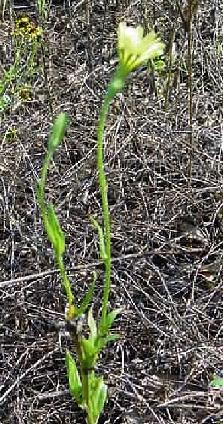 |
False-dandelion - Pyrrhopappus carolinianus
Yellow flowers look like dandelions, and false dandelion produces a milky juice like dandelion, the leaves are not as sharply divided as dandelion
leaves. While dandelion has a basal rosette of leaves, false dandelion has a few stem leaves as well. Upper leaves become gradually smaller. Flowers
are open in the morning, but then close in the heat of the day. |
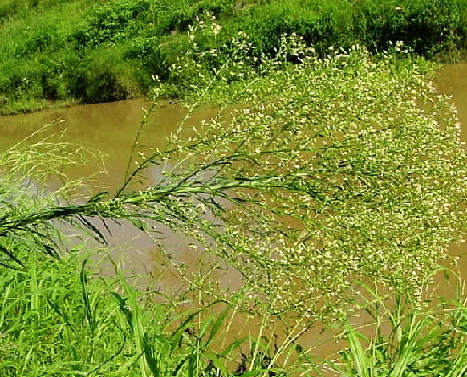 |
Horse Weed - Conyza sp.
Horse weed is an annual native plant growing up to 5ft tall. The light green stems are hairy and the leaves are slender with a toothed margin. The
leaves grow in an alternate arrangement up the stem. The plant blooms for 2-3 weeks between mid-summer and autumn. It can have no apparent floral
scent or it is mild and sweet. Habitats include prairies, fields, and pastures. The flowers attract small bees, wasps, flies, and other insects.
Some insects feed on the leaves and stems. The plant can irritate the skin of some people. |